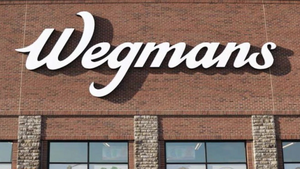Walmart is still the king of techWalmart is still the king of tech
The retail giant drove several tech initiatives in 2024, including automation in its distribution centers, artificial intelligence, and digital shelf labels

For years Walmart has been a tech leader in grocery, but perhaps no more so than over this past year, during which time the retailer set a rapid pace for ramping up automation at its fulfillment centers and distribution centers.
By 2025, Walmart has plans to build around 100 automated small fulfillment centers attached to existing stores. Automation of the centers is a critical company initiative, which the retailer predicts will turn a profit within the decade. In July, the Bentonville, Ark.-based retailer said it was adding four highly automated perishable distribution centers around the country and adding automated tech to five others.
The new tech includes an automated storage system nearly 80 feet tall in a temperature-controlled environment, which aids in the building of pallets engineered to optimize efficiency for merchandising at the store level and minimize product damage.
Walmart first built an automated perishables DC in Shafter, Calif., in 2021. The retailer built additional automated DCs this year in Lancaster, Texas, Wellford, S.C., Belvidere, Ill., and Pilesgrove, N.J.
In October, Walmart said it was installing high-tech automation in regional DCs in Buckeye, Ariz., and Searcy, Ark. Once finished, the centers will be able to ship nearly double the number of cases compared to a traditional regional DC.
“Automation in and of itself is something that is gaining scale in retail and it would not surprise me if there are larger efforts to further automate distribution centers because of some of the efficiency gains that the supply chain realizes,” said Marc Scott, an associate professor at University of Arkansas’ Sam M. Walton College of Business. “It seems to be a key strategic initiative of Walmart.”
The retailer was in a quiet period at the time of publication of this piece and would not comment on its tech advancements this past year.
Walmart is also adding automation at the store level. In 2022, the retailer acquired Alert Innovation, which develops automated storage and retrieval systems for e-grocery fulfillment, to give its back-of-store automation a boost.
“I think [automation] will continue to be their focus because they want to cut costs in every possible way,” said Dinesh Gauri, a professor of marketing at the University of Buffalo’s School of Management. “Even without the acquisition [of Alert Innovation] the kind of automation is phenomenal.
“I have visited a couple of these distribution centers and they are just humongous,” Gauri said.
Taking away the swipe
Walmart made a groundbreaking move in September when the retailer announced a new pay-by-bank an option for shoppers.
The offering with global financial tech and payments company Fiserv is expected to officially launch in 2025 and will allow Walmart to avoid paying fees to credit card companies. With U.S. credit card fees making up 2.24% of the average transaction, even converting a fraction of consumers to pay-to-bank could mean billions of dollars in savings for the retailer.
Swipe fees have more than doubled over the last decade and hit a record $160.7 billion in 2022, according to the Nilson Report, a publication that covers the global payment industry.
“I know the merchant community for the longest time has been trying to find alternative payment methods to credit cards in particular to save on the processing and interchange fees associated with the cards,” said Elisa Tavilla, director, Debit Payments, for Javelin Strategy & Research.
Walmart actually began offering its pay-by-bank option, Walmart Pay, earlier in the year, but the system relied on the Automated Clearing House, which took three days to finalize transactions. The new system utilizes Fiserv’s NOW network, which means transactions show up immediately.
Entering pay-by-bank is uncharted territory for most grocers and smaller retailers and it remains to be seen what kind of success Walmart will have in terms of incentivizing shoppers to sign up for the offering.
Tavilia noted that Americans in particular have a love affair with their credit cards due to programs that offer points-based rewards and cash-back incentives.
Nick Ewan, senior editorial director for loyalty points website The Points Guy, said the lack of an incentive program could limit the offering.
“I think the level of adoption is really going to depend on what is in it for the consumer to use this option versus another option,” he said. “If there is not that added incentive like you would have with a cash-back credit card or rewards card then it might be a little more limited.”
Pushing ahead with AI
At the CES tech convention in Las Vegas in January, Walmart released a new search engine that uses artificial intelligence language models tying products to general inquiries.
The box retailer took it a step further in October, unveiling a strategy to accelerate adaptive retail through artificial intelligence, generative AI, augmented reality and immersive commerce platforms. The intention is to create hyper-personalized experiences for shoppers.
Walmart has additionally developed Wallaby, a series of retail-specific large language models that will primarily be used to create customer-facing experiences.
The retailer is also leveraging GenAI platforms to create a more personalized version of its AI-powered customer support assistant online. The assistant recognizes who the customer is and goes beyond just understanding the customer’s intent to taking actions, like finding orders and managing returns.
During testing, customers reported an overall smoother experience that helped them handle issues quickly and on their own.
Walmart’s Content Decision Platform, announced in October, leverages AI-based tech to understand customers and a GenAI-powered tool that can predict the type of content the customer would like to see on the website.
Walmart has also developed an adaptive retail platform called Retina, which leverages AI, GenAI, and automation to create 3-D assets along with immersive commerce APIs.
Within the immersive avatar-based social platform, customers are able to buy items from Walmart’s No Boundaries brand for their virtual avatars and the matching real-world item for themselves.
But wait, there’s more
Walmart made other cool tech moves this year, including:
The big box retailer decided in 2024 it will go with digital shelf labels moving forward, and will officially launch the tech in stores in 2026
Another interesting move came in the waste arena, where Walmart will be working with food waste recycler Denali with depackaging services
Walmart’s $2 billion purchase of TV manufacturer Vizio was also considered groundbreaking as the retailer became the first to claim ownership of TVs inside of stores so it can offer enhanced digital retail media offerings to CPGs
Even away from the brick-and-mortar Walmart was making a tech impact. In June the retailer announced it was partnering with Agritask, a crop supply intelligence company, on a pilot aimed at finding a tech solution geared to enable generating more well-informed decisions on seasonal fruit crop yields
One tech solution that entered with a lot of hype has died down somewhat. Drone delivery kicked off earlier in the year but due to high costs, Walmart decided to focus on just the Dallas, Arkansas, and Virginia markets
Walmart continues to take the lead in tech development and it will be interesting to watch how some of the innovations, especially in the world of automation, play out in the coming months. Clearly, the big box retailer doesn’t appear to be slowing its pace on tech as long as it helps towards store/labor efficiencies and enhancing relationships with shoppers.
Read more about:
WalmartAbout the Author
You May Also Like






